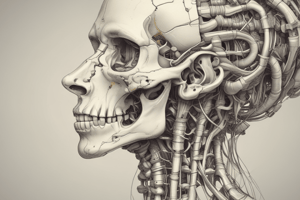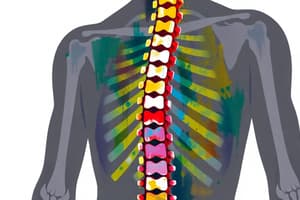Podcast
Questions and Answers
The vertebral column primarily relies on rigidity for its function.
The vertebral column primarily relies on rigidity for its function.
False (B)
Rigidity in the vertebral column is comparable to a ship's mast extending from the head to the pelvis.
Rigidity in the vertebral column is comparable to a ship's mast extending from the head to the pelvis.
True (A)
The plasticity of the vertebral column allows for changes in its rigidity.
The plasticity of the vertebral column allows for changes in its rigidity.
False (B)
Muscular tighteners in the vertebral column adapt their tension to restore equilibrium.
Muscular tighteners in the vertebral column adapt their tension to restore equilibrium.
The shoulder girdle supports a sail set longitudinally at shoulder level.
The shoulder girdle supports a sail set longitudinally at shoulder level.
The stays linking the mast of the vertebral column to its attachment site are predominantly ligamentous.
The stays linking the mast of the vertebral column to its attachment site are predominantly ligamentous.
The primary function of the spinal column is to provide flexibility for the trunk.
The primary function of the spinal column is to provide flexibility for the trunk.
There are a total of 33 vertebrae and 24 intervertebral disks in the human spinal column.
There are a total of 33 vertebrae and 24 intervertebral disks in the human spinal column.
There are more lumbar nerve roots than thoracic nerve roots in the spinal column.
There are more lumbar nerve roots than thoracic nerve roots in the spinal column.
Vertebrae that form a posterior convexity in the sagittal plane are known as kyphotic curves.
Vertebrae that form a posterior convexity in the sagittal plane are known as kyphotic curves.
The vertebral column only serves as a protector for the bones in the extremities.
The vertebral column only serves as a protector for the bones in the extremities.
Sacral nerve roots are found in both the thoracic and lumbar regions of the spine.
Sacral nerve roots are found in both the thoracic and lumbar regions of the spine.
Primary curves in a baby's vertebral column are convex anteriorly.
Primary curves in a baby's vertebral column are convex anteriorly.
Secondary curves in a baby's vertebral column develop during infancy.
Secondary curves in a baby's vertebral column develop during infancy.
The thoracic and lumbar regions of the vertebral column have primary kyphotic curves.
The thoracic and lumbar regions of the vertebral column have primary kyphotic curves.
The vertebral body consists of spongy bone surrounded by a thick cortical bone.
The vertebral body consists of spongy bone surrounded by a thick cortical bone.
The margins of the vertebral body are rolled up into a lamina derived from the epiphyseal disc.
The margins of the vertebral body are rolled up into a lamina derived from the epiphyseal disc.
The trabecular systems within the spongy bone of the vertebral body help resist compression and vertical forces only.
The trabecular systems within the spongy bone of the vertebral body help resist compression and vertical forces only.
Area of weakness in the body is commonly found in the posterior portion.
Area of weakness in the body is commonly found in the posterior portion.
The area of strength is located where the trabecular system intersects.
The area of strength is located where the trabecular system intersects.
The entire spine is composed of four columns, with one major column and three minor columns.
The entire spine is composed of four columns, with one major column and three minor columns.
Spinal curvatures help to decrease resistance to axial compression forces.
Spinal curvatures help to decrease resistance to axial compression forces.
The resistance R of a curved column is inversely proportional to the number N of curvatures + 1.
The resistance R of a curved column is inversely proportional to the number N of curvatures + 1.
The Delmas index quantifies spinal stability using the ratio H/L x 100.
The Delmas index quantifies spinal stability using the ratio H/L x 100.
Compression fractures in the vertebrae are likely to occur in areas of strength.
Compression fractures in the vertebrae are likely to occur in areas of strength.
The three columns in the spine consist of two major columns and one minor column.
The three columns in the spine consist of two major columns and one minor column.




